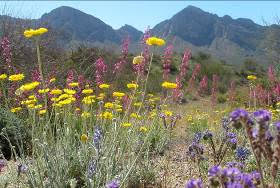Wildflowers are the April Plant of the Month!
“Flowers are sunshine, food, and medicine to the soul.” —Luther Burbank
California poppies growing along Interstate 8, outside of the Arizona state line.
One of the first signs of spring in the Southwest desert is the emergence of magnificent wildflowers. These prolific displays of color are presented after the winter rains have soaked the desert during fall and winter. The greatest wildflower displays occur when winter rains are plentiful and well spaced. During years of lighter rainfall, wildflowers may make a less substantial color show.
The spring wildflower season in the Southwest desert runs from March through May, depending on winter rains. The summer wildflower season runs from July through September. Varieties and types of wildflower color include colors across the spectrum—blue, white, yellow, lavender, purple, orange red, and pink. Likewise, the choices for a wildflower garden are endless.

Penstemon, desert marigold and assorted perennials growing along the roadside in Oro Valley, Arizona
Wildflowers are an excellent way to add color and beauty to any landscaped area. Wildflower gardens are low-maintenance and require minimal water once established. After all, they grow on their own in the wild without cultivation. There are over twenty thousand species of wildflower plants in North America. They can be found as annuals, perennials, and biennial plants. Annual wildflowers are plants that perform their entire life cycle from seed to flowers and back to seed in one year. Perennials are plants that grow for many years. The top portion of the plant dies each winter and then re-grows the following spring. Biennial wildflowers are plants that require two years to complete their life cycle. The flowers or blooms form in the second season. Some wildflower plants can be an annual or perennial, depending on climate or geographic location.
The best way to start your wildflower garden is to buy or collect seed. Wildflower seed can be purchased from local nurseries, seed suppliers on the Internet, or collected from plants at the end of their blooming period in spring, summer, or fall. Seeds mature at different times and rates. Observe plants to make sure you collect the seed at the optimal time; ripe seeds usually turn dark in color and are easy to spot. Spring flowering plants produce mature seeds in late May or June, and summer blooming wildflowers develop seed in early fall.
An easy way to collect seed is to loosely tie paper bags around the seed head as it is dying out. Punch a few small holes into the bag for air circulation. Gently tap the plants when ready and the seeds will drop into the bag. Another option is to carefully shake the seed heads over a container. Collect seeds on a calm, sunny day, screening your seeds through a tiny kitchen colander to separate them from plant parts and leaves. Allow the seeds to dry out thoroughly before storing in tightly sealed containers. Moisture may hasten the growth of mold, which will damage the seeds. Consider adding a packet of silica gel to the container to remove excess moisture. Label each container and store them in a cool dry place.


Lupine and African daisies
When planting wildflower seeds, select a site in your garden that drains well, is rich in nutrients, and is a wide-open space. Wildflowers do not like hard-packed soil. They need moisture, but not too much and at least eight hours of sunlight each day to avoid spindly, small blooms.
Remove any weeds or noxious plants from the area to prevent competition for sunlight and soil nutrients. Prepare the wildflower bed by raking and lightly tilling the surface of the soil to a depth of one inch or less. Do not disturb the soil any deeper or you may stimulate dormant weed seeds in the soil. Remove all weeds by hand prior to planning wildflower seeds. If lots of weeds are present, use an herbicide. Wait a week or so before planting the wildflower seeds. Water the area again, and if the weeds come back, reapply herbicide. The more weed-free the bed is, the more success you will have.


Colorful wildflowers displaying their spring color along Highway 86, just west of Sells, AZ
Most wildflower seeds require specific soil and temperature conditions to germinate properly. They prefer warm soils between sixty-eight and seventy degrees. The best time to spread the seed is in late fall to early winter, well before the first frost. Sow summer and fall blooming wildflower seed in early summer before monsoons start. Use a handheld broadcaster to spread the seed, or spread it carefully by hand. Mix potting soil, sand, or vermiculite with the seed before spreading. When distributing the mixture, walk in straight lines dropping a little at a time. Then crisscross the area so you are spreading seed evenly throughout the bed. Press seed lightly into the soil. Do not worry if some of the seed is visible on the soil surface. Poor germination may result if the seed is planted too deep.
Wildflower seeds require moisture to germinate. Keep the area moist for about four to six weeks and do not let seedlings completely dry out. Irrigate your seeds three times per week if the natural rainfall is inadequate. When the seedlings begin to germinate, apply light irrigation to the bed, but do not over-water it—maintain this schedule until your seedlings are one to two inches. Germination occurs within one week to twenty-eight days, depending on varieties. Since birds are attracted to seed as a food source, you may need to install bird netting over the bed for protection. Wildflowers do not need to be fertilized, and fertilizer might promote unwanted weed growth.
Start collecting seeds and have fun creating colorful wildflower gardens. Some common wildflowers to collect are the desert bluebell, owl’s clover, Indian paintbrush, desert globe mallow, desert marigold, African daisy, penstemon, California and Mexican poppy, Gooding’s verbena, desert lupine, golden fleece, paper flower, desert zinnia, Arizona bluestar, and many others.



